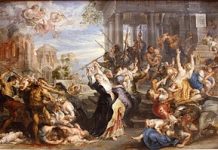
Jesus has redeemed sinners through his passion, death, and resurrection, and this paschal mystery can never be fully grasped by the human mind. However, God has given Christians many opportunities to deepen their understanding of it in scripture. The Old Testament has many examples of types, or prefigurations, of Christ, which shed light on particular aspects of his redemptive actions. In the Mosaic Law, the kinsman redeemer is one such example.
In the Law given to Moses, the Hebrew word “goel” is usually translated in the Bible as “kinsman redeemer.” The kinsman redeemer is the nearest male relative to family members facing an injustice of some sort, and he has four main tasks. The redemption from the kinsman redeemer’s accomplishment of each of these four tasks prefigures the redemption won by Jesus. The first task is to marry the widow of a deceased brother or other male relative, however the case may be (Deuteronomy 25:5-10). The story of Ruth and Boaz is an example of this, except that Boaz is not the closest male relative of Ruth’s late husband. He asks the elders of his community for special permission to perform the duty of the kinsman redeemer for her because he loves her. This is a prefiguration of Jesus, who is a divine and not a human person, but condescends to take on a human nature in order to take his beloved church as his redeemed bride. The second job of a kinsman redeemer is to buy back his family member that sells himself into slavery (Leviticus 25:47-29), and the parallel here between the kinsman redeemer and Jesus is quite clear. Human beings are commonly described as enslaved to sin, and through the paschal mysteries, Jesus has bought us back. As the Exultet proclaims during the Easter Vigil, the climax of the liturgical year, “O love, O charity beyond all telling, to ransom a slave, you gave away your Son!”[1] Thirdly, when someone in the family sells family property, i.e. the family’s inheritance from God upon having entered the Promised Land, the kinsman redeemer purchases it back (Leviticus 25:25-28). Jesus fulfills and transcends this by offering sinners an even better inheritance than original justice in the Garden of Eden which they lost; eternal participation in the life of the Holy Trinity (Ephesians 1:14).
The fourth task of the goel is to kill anyone who murders a family member, and in this context, goel is translated as “avenger of blood” (e.g. Numbers 35:19). The connection between this and Jesus is much less intuitive than the other three instances of the kinsman redeemer. This connection can be illuminated with some clarifications and considerations about certain elements of the avenger of blood.
First, it is important to maintain that the avenger of blood is established by God himself, and so the practice is just for the context of the Israelites during the time of Moses. It is not as though the Israelites were immoral, and now human beings are moral, and that is why humans address murder differently now. It is true that Jesus himself says that the lex talionis, usually summed up in the phrase, “an eye for an eye, a tooth for a tooth” no longer applies (Matthew 5:38-48). He also indicates that “for the hardness of [their] hearts” Moses permitted at least divorce (Matthew 19:8). So it would not be a stretch to conclude that perhaps the lex talionis was only tolerated for similar reasons. These measures were never “ideal.” However, he also says he has not come to abolish the Law, but to fulfill it (Matthew 5:17). There are important elements of justice contained in the role of the avenger of blood which now teach about the redemption that Christ won through his cross, its fulfillment.
At the same time, since it does not apply anymore, the response of the avenger of blood is no longer a just practice, and capital punishment is now permissible for different reasons than the reasons for which the avenger of blood is appropriate in the context of Mosaic Law. Previously, paragraph 2267 of the Catechism of the Catholic Church stated that capital punishment is permitted for the purpose of community defence alone. The 2018 revision went even further than this, stating that it is never necessary anymore because community defense can be guaranteed by other means. In either case, it is only permitted, when it is permitted, for the sake of community defense.
However, community defense does not seem to be the primary goal of the avenger of blood, even if it should result as a consequence. The avenger of blood’s punishment is the same as the crime he addresses. Moreover, the agent who carries out the capital punishment is specifically the nearest male relative of the murdered person. Both of these elements point more to a darker, but still legitimate, purpose of punishment: retribution.
Retribution comes from the Latin word retribuere, to pay back. When someone commits an injustice, an agent of retribution rewards, or pays back, the unjust person with punishment. Redemption comes from the Latin word redimere, to buy back. When possession of something is lost, a redeemer buys it back in order to recover it. Both of these concepts involve first, an evil and second, a response with the character of a payment which restores the equality of justice.[2] So, the mystery of the avenger of blood’s typological fulfillment in Christ may be solved in part by the “economic” connection between retribution and redemption.
Sin, and man’s consequent separation from God, are the evils which Jesus addresses in his passion, death, and resurrection. The retributive element of this evil is best understood from the human being’s perspective. Eternal punishment is the payback which human beings earn through sin, since sin destroys the relationship between God and human beings, who were created precisely for a relationship with him. This spiritual retribution is very real and harsh. The redemptive element of sin is better understood from God’s perspective. When human beings sin, they separate themselves from God, and therefore God no longer has possession of them as his children. Of course, he does not suffer from this, or lose anything which might add or subtract to his happiness, since he does not have that sort of vulnerability in relation to human beings. However, in his merciful regard for us, he still desires to regain this possession.
When the second person of the Trinity takes on a human nature, retribution and redemption meet in order to solve the problem through a payment. Jesus, who is God the Son, and the Son of Man, is the kinsman of both God and man. Therefore, he is able to exact the payment which sin demands in just retribution. He is also able to make the payment which gains back God’s possession of humanity in an act of redemption. Indeed, as God and man, these two actions of retribution and redemption become one and the same.
The payment which Jesus makes in order to accomplish retribution and redemption is a sacrifice. He is the priest and victim of this sacrifice, which is his very life offered on the cross. In order to be priest and victim, his divinity is necessary. As the Catechism of the Catholic Church states, before Jesus, “[n]o man, not even the holiest, was ever able to take on himself the sins of all men and offer himself as a sacrifice for all.”[3] However, it is also essential for him to take on a human nature, and thus become the kinsman of humanity. Otherwise he could not make the payment necessary for redemption. Every payment is a sacrifice of some sort, because resources are finite, and therefore every purchase involves sacrificing another potential purchase. In the discipline of economics, this is called the opportunity cost. In a sense, God qua God is not capable of making a payment which is a sacrifice, because God qua God does not have finite resources, and he does not lose anything by giving. However, by taking on a human nature and becoming a kinsman of human beings, he makes himself temporarily vulnerable to suffering, and thus empowers himself to sacrifice.
Since Jesus is both priest and victim, the payment he makes does not consist of God the Father taking out his wrath upon God the Son, in the place of sinners. This would represent a misunderstanding about the nature of both eternal damnation and the sacrifice which frees sinners from it. Eternal damnation is separation from God. Jesus is God, and he cannot be separated from himself. Therefore, his payment does not consist of suffering the eternal damnation that all human beings otherwise would have experienced. Instead, he lovingly endures a different sort of suffering in exchange, fully measured and comprehended by God alone. This suffering which he endures in exchange is even more generous than the amount required. Thus, he superabundantly satisfies for the eternal damnation, and brings humanity back to a familial relationship with God. So it is clear that God the Father is not taking out his wrath upon his Son. In Christ’s sacrifice, all three Persons of the Trinity are united, in love for each other and for humanity; God the Father freely offers his beloved Son, and the Son freely offers his life to the Father through the Holy Spirit.[4]
The avenger of blood takes severe measures to establish justice in the Mosaic Law, demonstrating the dark reality that murder comes at a great cost. Similarly, the severity of crucifixion, and of all the accompanying sufferings which Jesus endures during his passion, demonstrates that, from the perspective of retribution, the cost of sin is great indeed. However, since Jesus links retribution and redemption, he shows that the price which he is willing to pay out of love for humanity is equally great. Thus, in this union of the avenger and saviour, of retribution and redemption, God as priest and victim reveals the immense accomplishment of the paschal mystery.
[1] https://www.usccb.org/prayer-and-worship/liturgical-year-and-calendar/easter/easter-proclamation-exsultet.
[2] ST IIa IIae, Q 59, a. 2.
[3] Catechism of the Catholic Church, 616.
[4] Catechism of the Catholic Church, 614.










